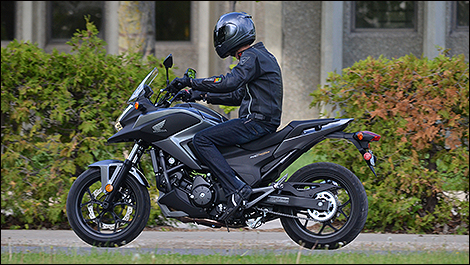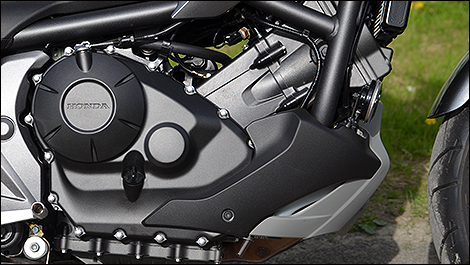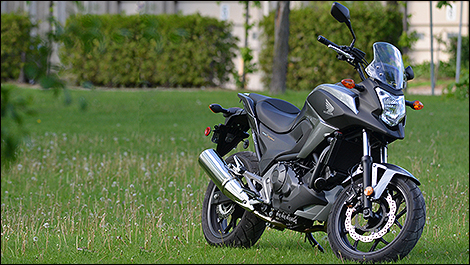Honda's new NC gets a bump in displacement and a few cosmetic upgrades. It's a unique product that fills a small but interesting niche, and displays exceptional versatility.
Whether you like the design or not, this machine is best appreciated from the comfort of its nicely sculpted rider's seat. In terms of fit and finish, colour coordination has been improved, and the plastic fairings emphasize its athletic silhouette. Unfortunately, the
NC750XA still lacks radiator cowls that would add a premium touch. Overall, though, it reminds me of the
Ducati Multistrada, one of the most stylish adventure bikes on the market.
The NC750XA has all the practical features found on the smaller NC700 including a fake tank that can hold a full-face helmet (the real tank lies under the seat). Just turn the ignition key clockwise to open the cargo case, and counter clockwise to lift the passenger seat that hides the fuel cap. Make sure you don't leave the key inside the case, because it automatically locks when you close it.
Docile and responsive
The 2014 Honda NC750XA is pretty nimble and easy to steer through traffic, complete with a fairly laid-back, adventure-type riding position that's great for low-speed situations. The small windscreen does a nice job of directing airflow away from the rider, the long-travel suspension effectively absorbs road imperfections, and the seat is comfortable enough to ride for hours without feeling any pain.
The fork and rear shock felt firm for my 65 kg, suggesting that they are more than capable of handling two people and some luggage. Elsewhere, the controls are smooth and precise, while Honda's combined ABS provides a feeling of safety that's almost unrivalled in this segment, even from bikes that cost in excess of $10,000.
 |
| The 2014 Honda NC750XA is pretty nimble and easy to steer through traffic, complete with a fairly laid-back, adventure-type riding position that's great for low-speed situations. (Photo: France Ouellet) |
Larger displacement
The boost in displacement and midrange output is validated on the road. The 2014 Honda NC750XA delivers more convincing accelerations and passing manoeuvres while burning the same amount of fuel as before (4.4L/100km after a mix of 70% city and 30% highway riding). The engine's sweet spot still resides between 2,000 and 4,200 rpm, and the electronic rev limiter kicks in around 6,300 rpm.
The parallel twin feels lively and eager to please, due in part to a friendly transmission that features long gear ratios allowing you to make better use of all the torque at your disposal. The engine is surprisingly docile and loves to rev, in true Honda fashion, but it lacks of top end. During sporty riding, hitting the rev limiter is almost a given, which quickly becomes annoying and frustrating. The NC750XA is the prototypical midrange bike that forces you to use a higher gear in order to keep the revs lower.
 |
| The engine's sweet spot still resides between 2,000 and 4,200 rpm, and the electronic rev limiter kicks in around 6,300 rpm. (Photo: France Ouellet) |
DCT sadly unavailable in Canada
In Europe, Honda offers a dual-clutch transmission that's perfect to get the most out of the NC750XA. Derived from the VFR1200, it includes auto modes that basically eliminate said irritant. Let's cross our fingers and hope that Honda brings this unit to our shores.
Regardless, the NC750XA stands out where versatility, accessibility, stability, and precision are concerned. Its ultra-friendly and docile engine delivers power in a way that increases the rider's confidence, no matter how experienced they are. It will rapidly put beginners at ease and allow everyone to ride freely and safely in just about all conditions.
 |
| Regardless, the NC750XA stands out where versatility, accessibility, stability, and precision are concerned. (Photo: France Ouellet) |
Pros
- Sharp and nimble
- Ergonomic and comfortable
- Fuel-efficient
- Practical
Cons
- Excessively short powerband

